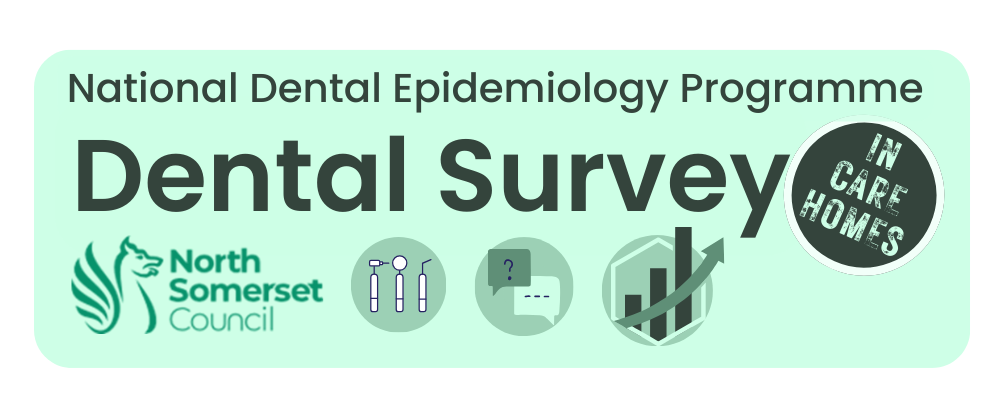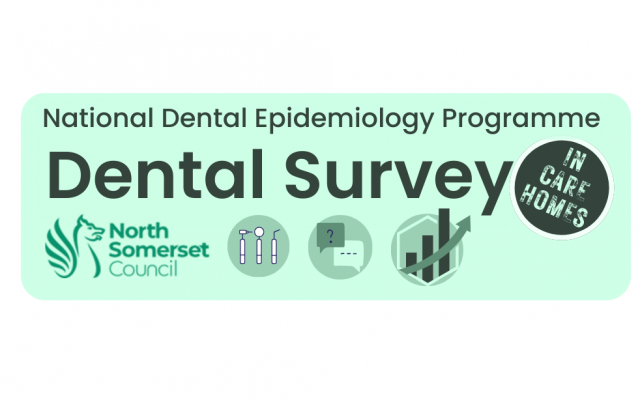Oral Public Health Specialist
North Somerset Council
Public Health, Post Point 11, Castlewood, Tickenham Road, Clevedon, BS21 6FW
The Office of Health Improvement and Disparities (OHID) has responsibility for coordinating dental health surveys across England. These surveys form what’s known as the National Dental Epidemiology Programme (NDEP) and are conducted to standards set by the British Association for the Study of Community Dentistry (BASCD). These surveys have resulted in robust, comparable data for use by local and national government and the NHS. Responsibility for commissioning the surveys in North Somerset lies with North Somerset Council, but is done so via the Bristol, North Somerset and South Gloucestershire (BNSSG) Integrated Care Board (ICB), who have commissioned dental providers to undertake the fieldwork according to a national protocol.
Information from the surveys is vital to inform oral health needs assessments at a local level. Public health teams and ICB commissioners use the information when planning and evaluating local health services and health improvement interventions.
Every other year, the NDEP surveys 5-year-olds giving authorities regular snapshots of the prevalence of oral health and diseases amongst young children. See the OHID report of the 2022 5-year-old survey. The alternate years, the survey covers a different population. This page gives information for those who want to know more about the upcoming survey.
Dental Health in Care Homes Survey 2025
What does the survey involve?
The survey will be two fold and involve
- a clinical examination from a dentist, who will be looking for signs of experience in oral disease, such as decay, missing and filled teeth and other signs of infection.
- an interview with a member of the research team to talk about how oral health impacts daily living, such as eating and socialising.
Who will be included?
The survey will be of adults aged 65 years and older living in residential or nursing care homes and who have capacity to consent to participate in the survey.
Inclusion criteria
The inclusion criteria for the survey are:
- adults aged 65 or over residing in one of the randomly selected care homes
- adults who can understand the purpose and nature of the survey and give informed consent to both the interview and the clinical examination
Exclusion criteria
The exclusion criteria for the survey are:
- adults unable to understand the information detailing the purpose and nature of the survey and who are unable to give informed consent
- adults receiving palliative, end of life or respite care
How will the Care Homes be selected?
Within each local authority a minimum number of 100 people aged over 65 years will be sampled, drawn from a minimum of 6 and a maximum of 10 care homes.
It is likely that the following procedure will be used to randomly select the care homes involved:
The Care Quality Commission will provide a list of care homes for each local authority area. Hospices and end of life residences will be excluded from the list. The list will then be checked by staff at each local authority who are familiar with the care homes in their area.
The final list will be sent to fieldwork teams for sampling.
To sample, the list of care homes be stratified into 6 groups according to:
- nursing or residential or mixed status
- number of beds (0 to 49 and 50 or more)
One care home will be randomly selected for each of the 6 groups. Fieldwork teams will then need to contact the manager of each sampled care home to seek cooperation with the survey. Where managers decline to take part, this will be recorded and the next sampled care home from that category will be approached. Participating care homes have been asked if they can seek consent to participate from every eligible resident. If the total number of participants is less than a hundred, more care homes will be randomly selected.


